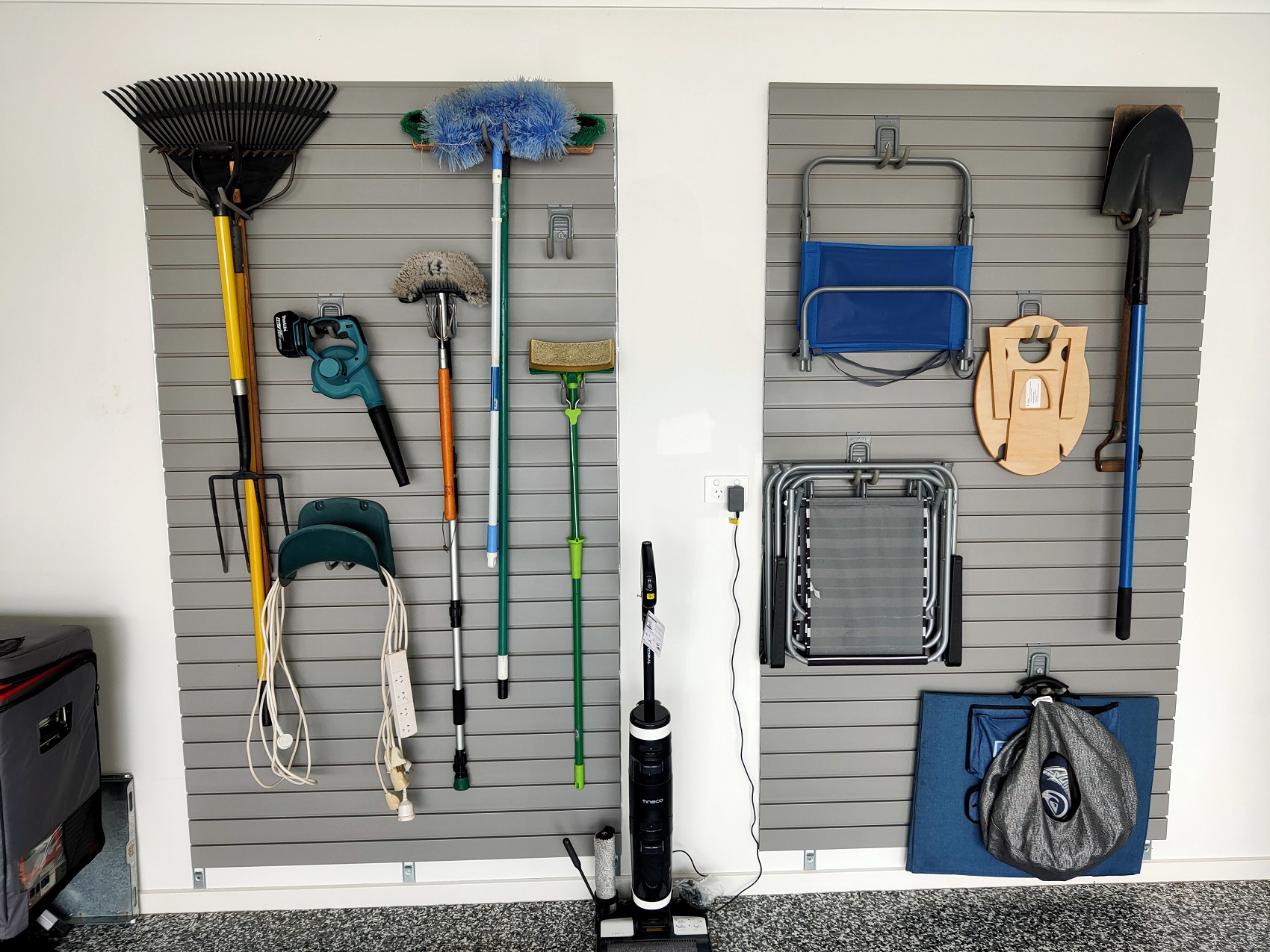
Today we are tackling the common question of “Choosing the Right Garage Storage System: Rail vs Full Wall Panel”. Organising your garage begins with selecting the storage system that matches your space, needs, and budget. Whether you’re considering a quick and affordable rail solution or a robust full-wall panel system, the right choice can transform a cluttered garage into an efficient, well-organised workspace. This guide explores the key differences between rail systems like StorEase and StorTrak and premium full-wall solutions such as StoreWALL, helping you decide which option is best for your home.
Rail-Based Systems: Convenience Meets Cost-Effectiveness

StorEase by Bunnings
- Versatile & Easy to Use: StorEase offers modular slat rails and hooks that let you set up storage in minutes. Ideal for beginners or minimalistic setups. Each rail has a specified load capacity of 150kgs. Honestly unsure how you can support this weight with 4 screws.
- Quick Installation: Suits garages, laundries, and sheds where you need fast, simple organisation.
- Affordable Starter Kits: The Storease Garage Storage System starter kit includes around 2.4 meters of rail and assorted hooks for about $99, making it great for light-duty use.

StorTrak by Mitre 10
- Medium-Duty Rail Strength: Steel rails handle up to 150 kg per linear meter, making them suitable for heavier tools or equipment. This is the same load capacity as the Bunnings StorEase product. Honestly unsure how you can support this weight with 4 screws.
- Locking Hooks: Features grip hooks with locking tabs to prevent accidental dislodgement—it latches at the top and the bottom, same as the Bunnings StorEase product.
- Expandable System: Modular components connect for longer, stronger storage runs.
- Affordable Kits – 12 piece kit with 2 x 610mm rails, and 10 light hooks – $99.
Best for:
- Small-scale storage needs (e.g., light tools, gardening equipment)
- DIY installs with minimal prep work
- Budget-conscious users needing basic vertical storage

Full-Wall Solutions: Superior Strength & Scalability
StoreWALL Panels
- Complete Wall Coverage: Unlike short rails, StoreWALL provides full coverage with durable, high-quality PVC slat panels that withstand heavy and varied loads. One 1.2m Standard Duty Wall panel would be supported with 3 pieces of installstrip (galvanised metal brackets), total of 12 screws. We state the load capacity at 56kgs at wall surface.
- Premium Look and Long-Term Performance: Offers a clean, seamless finish that lasts and performs in demanding environments.
- Secure Accessories: Every accessory uses the CamLok™ system, locking hooks and shelves firmly in place for lasting durability.
- Modular Flexibility: Easy to reconfigure hooks, baskets, and shelves to adapt as your storage needs evolve.
- Moderate pricing – A Gardener Starter Kit with 1 Standard Duty 1.2m Panel (equivalent to 4 rails), plus 1 x Heavy Duty Cradle Hook, 1 x Long Hook for paper towels, 4 x 127mm Single Hooks, 1 x 812mm Metal Ledge Shelf without brackets, and 1 x Heavy Duty Tool Hook is $302.99.
Best for:
- Full-garage fit-outs or multi-use workspaces
- Business, hobbyist, or trade users requiring high load capacity
- Professional finish and adaptability over time
Quick Comparison
| Feature | StorEase (Bunnings) | StorTrak (Mitre 10) | StoreWALL Full Panel System |
|---|---|---|---|
| Load Capacity | Light utility | Light utility | Superior heavy-duty support |
| Installation Ease | Very simple | Very simple | Moderate (modular & professional) |
| Customisation | Limited to rails length (610mm) | Limited to rails length (610mm) | Highly flexible & full-wall layout |
| Best Use Case | Occasional, light home use | Occasional, light home use | Professional, full-scale storage |
| Finish Aesthetic | Basic utility | Basic utility | Sleek, seamless, premium look |
| Price (Starter Kit Range) | Low (~$99) | Low (~$99) | Higher upfront, long-term value (Single Panel from $70) |
Final Recommendations
- Use StorEase or StorTrak if you need fast, affordable organisation for light use (e.g., tool pickup area, small garden storage).
- Choose StoreWALL for full-room conversions, serious organisational capacity, or an upgrade that scales and adds long-term value to your space.








